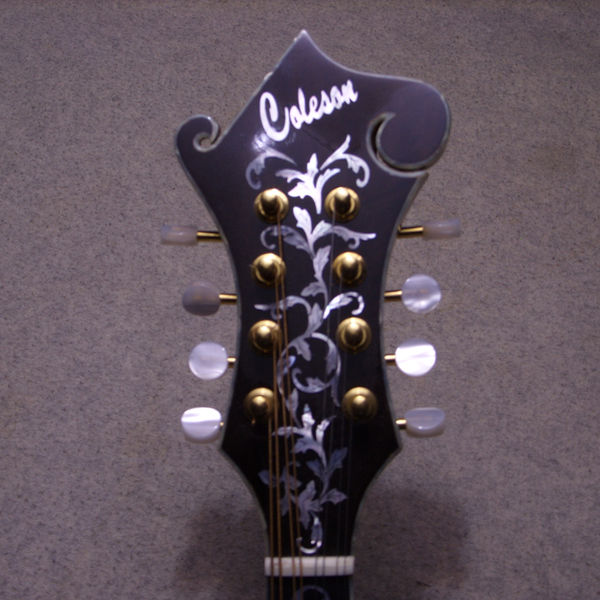TWO LINES
THE COLESON STANDARD LINE:
BEAUTIFUL IN ITS SIMPLICITY IT COMES WITH WHITE BINDING ON THE TOP ONLY. NICKEL PLATED HARDWARE, STANDARD DOT FRET BOARD INLAY AND TRADITIONAL FLOWERPOT PEG HEAD INLAY.
THE COLESON PREMIUM LINE:
THIS DELUXE STYLE COMES WITH TRI-LAMINATE IVOROID BINDING ON THE TOP AND BACK, IMITATION MOTHER OF PEARL BINDING ON THE FRET BOARD AND PEG HEAD, FANCY VINE AND LEAF INLAY ON THE FRET BOARD AND PEG HEAD, AND GOLD PLATED HARDWARE.
Both lines come complete with:
Hand graduated/tuned top and back plates
Spring-loaded graphite laminate parallel tone bars
Hand bent solid wood sides
Ebony bridge and fret board
Alaskan wild game bone
Nut
15th fret cross piece
Body protector points
Instruments are available for left-handed players in each line.
Options
In general, wood density levels range from medium to medium hard throughout all three species of wood I use. What truly indicates tone is properly carved and graduated sound plates. Birch, Maple, and Koa can all be brought into equal tonal qualities.
Tone Woods- for sides back and neck
Alaskan Birch- My favorite wood to work with. Although it's a less figured wood (curly or tiger striped) than Maple or Koa, it is stable, plentiful and produces great instruments.
Maple- The traditional wood for string instrument construction since at least the 1700s. It's highly figured and seems to be in good supply at the present time.
Koa- From Hawaii, it is a beautiful highly figured tone wood. Curly grain has been seen from trunk to branch in trees less than 20 years old. State and private reforestation projects will ensure a plentiful supply for future builders worldwide.
Top Plate Material
Spruce- The traditional tone wood for string instruments top sound plates. We have a large supply of Sitka Spruce here in Alaska.
Redwood- Proven to be an exceptional tone wood and is known to be highly decay resistant, potentially extending an instruments longevity.
Fret Board Surface
Flat fret boards are the standard for mandolin construction
Some players like a slight 16 inch radius to the fret board surface
The choice is individual preference
Fret Wire
Fret Wire (fine-medium) - Fine fret wire is the standard mandolin wire. Correct intonation is kept easily with it. Heavy-handed players who wear out frets fast should consider medium fret wire as you will probably be getting them leveled and re-crowned more often.
Medium fret wire allows for more fret resurface jobs to be performed before a complete re-fretting job is needed. Tone seems to remain the same with either fine or medium fret wire.
Fret Board Extension
The standard fret board extension is the 29th fret Florentine. However, some players don't like the extended fret board preferring a scalloped fret board extension to ease playability.
Personal Guarantee
Limited to the original owner is a guarantee to repair or replace (with another of the same mode) if instruments materials or craftsmanship are found to be faulty. This does not cover natural wear from playing or abnormal abuse (exposure to excessive temperatures, moisture or dropping instrument, etc.)
The warranty covers all cost of labor and materials to restore instrument. All shipping charges are to be paid by client.












